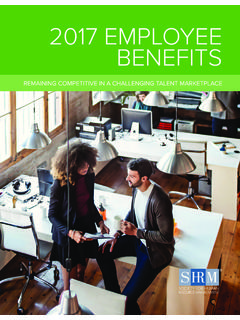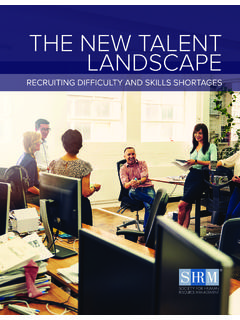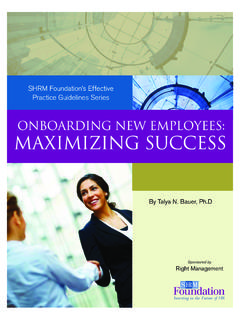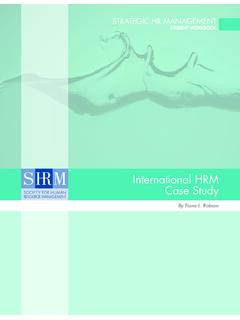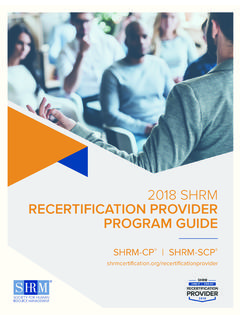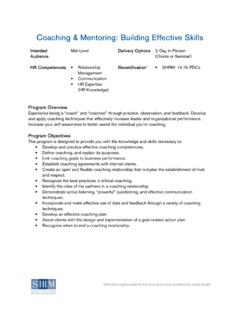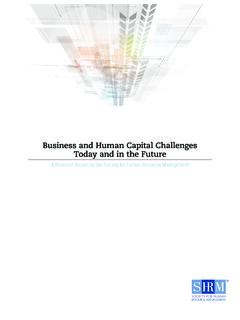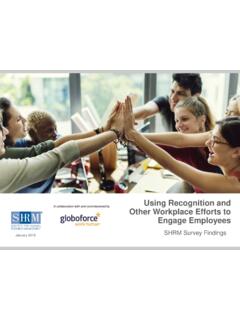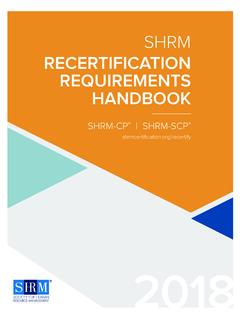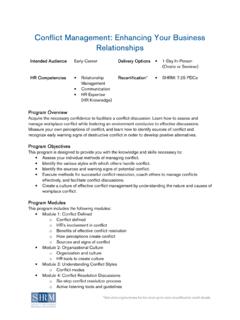Transcription of The Evolution of Human Resource Management
1 Employee and labor relations Instructor's manual The Evolution of Human Resource Management By Sandy Reed, SPHR, and Myrna L. Gusdorf, MBA, SPHR. Project Team Authors: Sandy Reed, SPHR. Myrna L. Gusdorf, MBA, SPHR. SHRM project contributors: Bill Schaefer, SPHR, CEBS. Nancy A. Woolever, SPHR. External contributor: Sharon H. Leonard Copy editing: Courtney J. Cornelius, copy editor Design: Jihee K. Lombardi, graphic designer 2010 Society for Human Resource Management . Sandy Reed, SPHR, and Myrna L. Gusdorf, MBA, SPHR. Note to HR faculty and instructors: SHRM cases and modules are intended for use in HR classrooms at universities. Teaching notes are included with each. While our current intent is to make the materials available without charge, we reserve the right to impose charges should we deem it necessary to support the program. However, currently, these resources are available free of charge to all. Please duplicate only the number of copies needed, one for each student in the class.
2 For more information, please contact: SHRM Academic Initiatives 1800 Duke Street, Alexandria, VA 22314, USA. Phone: (800) 283-7476 Fax: (703) 535-6432. Web: 10-0594. Instructor Notes About this Learning Module This learning module is divided into three classes and covers a brief history of American labor and the evolving function of Human Resource Management . The first class is an overview of American labor history from the colonial period to the early 1900s. There was little actual HR Management during this time, but it is important history that sets the stage for understanding the development of Human Resource Management in the 20th century. The second class covers early labor unrest at the beginning of the 20th century; the Depression; world War II; and the post-war years of the 1950s. In this time period, we see the rise of the industrial relations professional and the personnel administrator, forerunners of contemporary HR.
3 Managers. The last session starts with the civil rights movement of the 1960s and ends with contemporary issues that continue to shape today's HR Management in its current strategic role. Throughout the material you will see commentary on major historical events that, while seemingly unrelated to HR practice, will enable students to place the Evolution of HR into the context of the times. The material covers the social, political and economic issues that shaped the current practice of HR. The module is not intended to be a complete picture of labor history, nor is it intended to be a comprehensive catalog of issues that have affected HR; to do so would be an exhaustive study that could not be covered in three class sessions. The intent is to introduce students to the major historical events that influenced contemporary HR. Instructors may want to add other influences as time allows. It would also be instructive to ask students to consider their own ideas about the future of HR Evolution , particularly in light of technology and globalization.
4 Audience This learning module is appropriate for undergraduate students in a Human Resource Management or business Management program. Learning Objectives By the end of this module, students will: Recognize the interrelationship of social, political and economic issues in the history of American labor. Link the Evolution of contemporary Human Resource practices to events in labor history. 2010 Society for Human Resource Management . Sandy Reed, SPHR, and Myrna L. Gusdorf, MBA, SPHR 1. Assess the effect of current conditions on the practice of Human Resource Management . Formulate hypotheses regarding future Human Resource practices. Student Activities Each class session ends with discussion questions. These could be addressed as a whole class, or in small groups with group reports back to the class as a whole. Instructions for a final written analysis paper are included at the end of these instructor notes. The assignment asks students to consider the future Evolution of HR and how organizations and HR practitioners can prepare for that future.
5 PowerPoint Presentation A PowerPoint presentation with notes for the instructor is included. Suggested Readings Salvatore, P., Weitzman, A., & Halem, D. (2005). How the Law Changed HR. HR. Magazine, 13, 50, 47-56. Rubis, L., Mirza, P., Fox, A., Shea, T., & Moss, D. (2005). 10 Changes That Rocked HR. HR Magazine, 13, 50. Licht, W. (1988, February). How the workplace has changed in 75 years. Department of Labor Monthly Labor Review. Retrieved October 28, 2008, from The Evolution of Human Resource Management . Student Assignment 1. Read the three following articles: Salvatore, P., Weitzman, A., & Halem, D. (2005). How the Law Changed HR. HR Magazine, 13, 50, 47-56. Rubis, L., Mirza, P., Fox, A., Shea, T., & Moss, D. (2005). 10 Changes That Rocked HR. HR Magazine, 13, 50. Licht, W. (1988, February). How the workplace has changed in 75 years. Department of Labor Monthly Labor Review. Retrieved October 28, 2008, from 2. Write an analysis paper: Using ideas from class material and discussion, the assigned readings and your own research, write a three- to four-page paper (1,000 1,500 words) discussing the evolving future of HR practice.
6 Discuss factors you believe will have the most influence on the future of HR. Why do you think these are more influential 2 2010 Society for Human Resource Management . Sandy Reed, SPHR, and Myrna L. Gusdorf, MBA, SPHR. than other issues? What does this say regarding the future practice of HR? What should organizations do to prepare for the future, and how should HR students and practitioners prepare for the future? Submit your completed paper as indicated by your instructor. References A Curriculum of United States Labor History for Teachers. Illinois Labor History Society. Retrieved October 28, 2008, from #2. About the Society for Human Resource Management . Society for Human Resource Management . Retrieved October 28, 2008, from Abraham Lincoln. The White House. Retrieved October 28, 2008 from Hiring: Affirmative Action. Department of Labor. Retrieved October 28, 2008, from Questions and Answers about Employment Discrimination.
7 American Cancer Society. Retrieved October 28, 2008, from /content/MIT_3_2x_Questions_and_Answers_ about_Employment_Discrimination. asp?sitearea=MIT. An Outline of the Anita Hill and Clarence Thomas Controversy. George Mason University. Retrieved October 28, 2008, from /122/ Anteby, M., & Khurana, R. A. New Vision The Human Relations Movement;. Harvard Business School and the Hawthorne Experiment, 1924 1933. Harvard Business School. Retrieved October 28, 2008, from /hc/ #i. Assassination and Funeral of President John F. Kennedy. The Museum of Broadcast Communications. Retrieved October 28, 2008, from /etv/K/htmlK/ Bennett-Alexander, D. D., & Hartman, (2001). Employment Law for Business, 3rd ed. Irwin/McGraw-Hill. Better Things 1939. DuPont Chemical. Retrieved October 28, 2008, from Bombing of the Los Angeles Times. University of Southern California. Retrieved 9/18/08 from Bradley, B. (1998). American Cultural History 1950 1959.
8 Lone Star College. Retrieved October 28, 2008, from Cheek, J. S. (2005). The Roaring Twenties. Kennesaw State College. Retrieved October 28, 2008, from 2010 Society for Human Resource Management . Sandy Reed, SPHR, and Myrna L. Gusdorf, MBA, SPHR 3. Child Labor Public Education Project Child Labor in History. University of Iowa. Retrieved 9/25/08 from /child_labor/ Development of Social Security. Social Security Administration. Retrieved October 28, 2008, from E-Verify Program Highlights. Citizenship and Immigration Services. Retrieved October 28, 2008, from VgnVCM1000004718190aRCRD&vgnextchannel=a 16988e60a405110 VgnVCM. 1000004718190aRCRD. Employers Guide to Hidden Disabilities Accommodation (2003). Muhlenberg College. Retrieved October 28, 2008, from / Equal employment opportunity is the law. New Mexico Department of Workforce Solutions. Retrieved October 28, 2008, from / Farming in the 1930s. Living History Farm. Retrieved October 28, 2008, from Friedman, L.
9 M. (2002). American Law in the 20th Century. Yale University Press. Gardner, H. (2006). Changing Mind The Art and Science of Changing Our Own and Other People's Minds. Harvard Business School Press. Gold Rush and Alaska (2000-2007). Alaska Scenes. Retrieved October 28, 2008, from Hill, J. (1996). Illegal immigration fluctuates, study says. CNN. Retrieved October 28, 2008, from History of ASTD. American Society of Training and Development. Retrieved October 28, 2008, from History Place presents The Vietnam War. The History Place. Retrieved October 28, 2008, from Licht, W. (February 1988). How the workplace has changed in 75 years. Department of Labor Monthly Labor Review. Retrieved October 28, 2008, from Lewis, C. H. (2002). History of American Involvement in Vietnam: 1945-1975, University of Colorado. Retrieved October 28, 2008, from /AmStudies/lewis/2010 Mondy, R. W. (2008). Human Resource Management . Pearson/Prentice Hall.
10 4 2010 Society for Human Resource Management . Sandy Reed, SPHR, and Myrna L. Gusdorf, MBA, SPHR. The Story of Silent Spring. Natural Resources Defense Council. Retrieved October 28, 2008, from Republican Party Platform May 1860. Teaching American History. Retrieved October 28, 2008, from Robbins, S. P., & Decenzo, (2001). Fundamentals of Management , 3rd ed. Prentice Hall. Rubis, L., Mirza, P., Fox, A., Shea, T., & Moss, D. (2005). 10 Changes that Rocked HR. HR Magazine, 13, 50. Salvatore, P., Weitzman, A., & Halem, D. (2005). How the Law Changed HR. HR. Magazine, 13, 50, 47-56. Sage, H. J. (2006). The Roaring Twenties. Sage History. Retrieved October 28, 2008, from Schalch, K. (2006). 1981 Strike Leaves Legacy for American Workers. National Public Radio. Retrieved October 28, 2008, from Schur, J. B. Eli Whitney and the Need for an Invention. The National Archives. Retrieved October 28, 2008, from /cotton-gin-patent. Workplace Planning and Employment.
